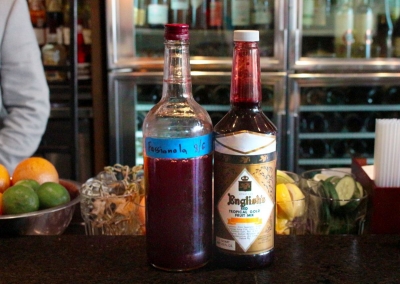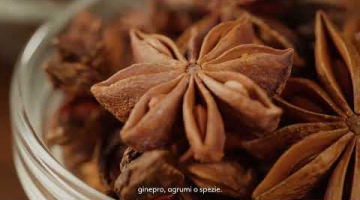As a general rule, syrups have a bad reputation among bartenders. But let's be clear, that disdain isn’t directed at the labor-intensive, house-made orgeats and demerara simple syrups batched at craft cocktail bars today. Rather, that contempt is directed at the sugary, chemical-laden cocktail mixers which dominated the drinks scene from the 1980s and well into the early 2000s.
The first craft cocktails—tiki cocktails—were built with syrups of all kinds, though. But at the best tiki institutions, like the original Don The Beachcomber and Trader Vic’s in Los Angeles, most of these cordials were made in-house with fresh fruit as far back as the 1930s. And among those was one now elusive mixed fruit syrup known as "fassionola," a staple ingredient in many original tiki drinks, especially those first crafted by Donn Beach, instigator of the tiki craze.
It's unclear whether or not Donn Beach actually invented fassionola, but during the early 1950s, the San Diego, California-based Jonathan English Company—a business which produced and sold a variety of bar mixes—decided to bottle its own version. But, according to tiki historian and Latitude 29 proprietor Jeff "Beach Bum" Berry who actually tried an old bottle of the stuff in the 1990s, the sugary, syrupy base had a mostly unremarkable flavor. "... it was really mediocre," says Berry.
Regardless, since fassionola was once a requisite ingredient in many original tiki libations, compounded with the fact that it's nigh impossible to obtain, bartenders are now searching for ways to resurrect the long-lost tincture as tiki’s revival rages on.
Rapscallion's house-made fassionola compared to the original. Photos by Katy Norris.
Despite its once ubiquity in tropical drinks, the flavor of fassionola itself is up for debate since the Jonathan English Company, the one oranization which manufactured it, has since gone out of business and most people, including tiki bartenders, have never tried versions from the 1930s. Which means that people interested in the syrup are just sort of guessing at its flavors. Some bar experts describe fassionola as tasting mostly of passionfruit, while others say that it channels more of a tropical taste akin to Hawaiian Punch.
Online tiki forums, of which there are several, are full of questions about fassionola, and the internet doesn’t seem to hold many answers. Most imbibers who are interested in mixing up Don The Beachcomber originals, like the Cobra’s Fang or a Pi Yi, aren’t able to find fassionola and want to know what to substitute for the most authentic drink. Those looking to recreate an authentic Hurricane—a classic cocktail invented at New Orleans bar Pat O’Brien’s during the 1940s—also seek the syrup, which gave the rum drink its trademark red color.
In 2006, Berry advised users of the forum TikiRoom to substitute Trader Vic’s Passion Fruit Syrup, a product that is still available today, but bears little resemblance to fassionola. Other tiki enthusiasts use undiluted Hawaiian Punch syrup, or skip it altogether. A quick-fix substitute frequently recommended online is a combination of pomegranate juice and raspberry Smuckers jam, reduced to a thick syrup.
Vintage Jonathan English fassionola recipes from the collection of Jeff "Beach Bum" Berry.
... bartenders are now searching for ways to resurrect the long-lost tincture ...
The Jonathan English Company was the first and only entity to ever retail fassionola, and they maintained a copyright on the name from the 1950s to 1984, approximately when the company dissolved. (There is no clear way to determine when, exactly, the Jonathan English Company closed, only a California Secretary of State’s Office record that lists the business’ dissolution year, 1984, and its founder, Patrick W. Rose, Sr.)
Curiously, an Angelfire website—a true antique—was built for the company in 2009, but all emails sent by Eater were returned as undelivered, and the phone number on the website is disconnected. At present, a brewery, 32 North Brewing Company, occupies the Jonathan English Company’s last known production address, and when reached for comment, owner Steve Peterson said he has never heard of the company, much less any idea about what happened to it.
It would seem that the Jonathan English Company simply vanished, but regardless, the interest in this long-lost syrup hasn’t faded. In most tiki recipes from the 1950s, fassionola's flavor is only described as a "tropical fruit blend." So, present-day bartenders dead-set on incorporating the ingredient into drink have had to approximate their own creations.
Of course, that can mean any number of fruit combinations, but Russell Thoede of Houston tiki den Lei Low believes that the syrup found its origins in a beverage that is widely available in Hawaii. Thoede first read about fassionola in a book of cocktail recipes written by Don The Beachcomber’s wife Cora "Sunny" Sund, who ran the Don The Beachcomber chain of restaurants when Donn Beach (born Ernest Gantt) fought in World War II.
Rapscallion cocktails built with fassionola: Rum Punch and a Fassionola Sour. Photos by Katy Norris.
"When I looked into where it came from, I thought that fassionola might come from Hawaii," says Thoede. "In Hawaii, they drink pog juice, made with passionfruit, orange, and guava. That’s my understanding of where Hawaiian Punch, and fassionola, come from—it’s just pog juice. But that’s only my theory." At Lei Low, Theode makes his own fassionola based on that theory by simmering mango, orange juice and passionfruit until it reduces into a thick, flavorful syrup.
Of course, every current recipe for fassionola is just a speculation. As Theode notes, you can’t just call up old-school bartenders and ask them if they remember fassionola, it’s too before their time. The only way to purchase a bottle of the original Jonathan English fassionola, which may or may not be the same recipe served at Don The Beachcomber, is to scour eBay. At present, nearly 100 bottles are for sale on the auction site, each around $20. There’s no way to determine their age, but one can assume that those bottles are quite old.
...every current recipe for fassionola is just a speculation.
Inspired by Theode’s creativity—he may very well have been the first bartender of this current tiki generation to make his own fassionola—Dallas bar manager Eddie Eakin of Rapscallion, a neo-Southern restaurant with a tiki-focused drinks program, set out to make his own, too. After trying the syrup in a drink at Lei Low, just a few hours south, Eakin won a bottle of Jonathan English Tropical Red Gold on eBay, and set to work in reverse-engineering the syrup. The resulting product, made with raspberry syrup, grenadine, and a secret tropical ingredient, is starkly different than Theode’s recipe, but does resemble the Jonathan English product in flavor, color and texture.
At Rapscallion, Eakin just recently added drinks to the menu that incorporate his housemade fassionola. His version of the Cobra’s Fang might not look much like Don The Beachcomber’s original, but it is an intricately flavored pour that showcases the best of tiki. Meanwhile, at Lei Low, Theode uses the syrup in his take on a traditional Zombie. Yet over at Berry’s Latitude 29 in New Orleans, fassionola is absent from the menu, though one will find "passion fruit syrup" instead.
While it's unclear whether or not those fassionola bottles sold on eBay contain the syrup's original 1930s formula, what's certain is that as curiosity about tiki cocktails continues to pique, more obscure ingredients will make their way onto cocktail menus. Fortunately, the current iterations of fassionola, orgeat, and other tiki relics likely now taste much better than their predecessors.
Update: Eater received word from Dan Huntley, current owner of the Jonathan English Company. Huntley purchased the business in 1993, and has continued to bottle private-label syrups and mixers under the "America's Finest Bar Supply" name. However, he no longer produces fassionola.
















